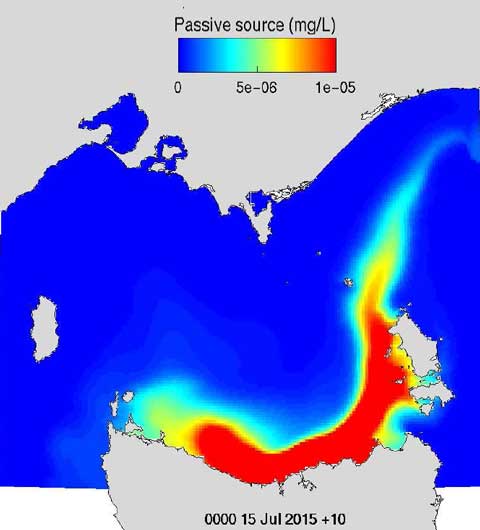In a nutshell
The report by CSIRO's Dr Mike Herzfeld was finally made public by Gunns after months of resisting its release. Greens Christine Milne had been trying to get the report released under Freedom Of Information but had been blocked by Gunns. The Company released the report just ahead of a departmental review of the FOI request.
The report found "The (64-million litre treated effluent) plume frequently undergoes extremely large, rapid, variations in position". In low current speeds the effluent would pool at the surface,"and as currents increased, it did not simply mix back to low concentrations, but would be transported many kilometres from the outfall. The modelling report found that concentrations in excess of the permit conditions would occurr in Commonwealth waters on almost a daily basis. The behaviour of the effluent plume generated by the Gunns' consultants (GHD) modelling appears "highly likely to be erroneous".
Read the Executive Summary
Numerical modelling has been performed to characterise the effluent plume from the proposed Bell Bay Pulp Mill outfall in Bass Strait. This modelling is preliminary in the sense that detailed comparisons of model results with measured data have not been performed so as to verify the accuracy of the model. It does, however, address many of the weaknesses present in the previous modelling commissioned by Gunns and performed by GHD.
Under appropriate configuration, and realistic parameterisation and forcing, the model indicates that the plume assumes the character of a long ribbon extending many kilometres from the outfall (e.g. Figure 4.4.1). The plume frequently undergoes extremely large, rapid, variations in position. When current speeds are low, the effluent released from the outfall pools at the surface. This results in high concentrations within the plume. As current speeds increase, the effluent is not simply mixed back to low concentrations, but rather transported many kilometres from the outfall by the currents as a coherent pool of high concentration (e.g. Figure 4.3.3).
The proposed extent of the mixing zone surrounding the outfall derived from modelling performed by GHD is considered to be an underestimate. The principal factor responsible for this underestimate has been identified as the use of excessive values of horizontal mixing in their model (e.g. Figure 4.6.3). For the space and time scales resolved by the model, these values are approximately an order of magnitude greater than that expected in the oceanic environment surrounding the outfall.
Using definitions of the mixing zone extent and Water Quality Objectives for chlorate as prescribed in the State Pulp Mill Permits, the modelling performed in this study indicates that the chlorate Objectives are frequently exceeded outside the mixing zone. Specifically, during the model simulation periods, concentrations in excess of the Water Quality Objectives’s were found in Commonwealth waters on almost a daily basis (e.g. Figure 4.4.4). There is every reason to expect that the mechanisms responsible for these exceedances would apply in other periods.
Get the full Herzfeld Report on Hydrodynamic Modelling of the Bell Bay Outfall

